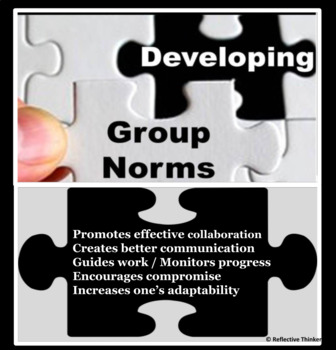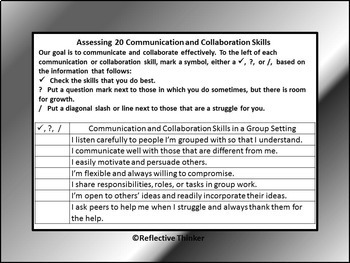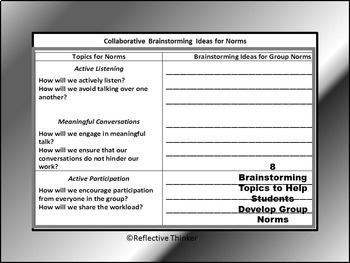21st Century Collaboration & Communication Skills: Developing Group Norms
- PDF
What educators are saying
Description
Perfect for establishing norms before students engage in collaborative work! A great resource for beginning of the school year. Students must learn how to effectively work together and be taught how to build positive and supportive relationships with diverse members of a group, which is a critical 21st century skill. Effective collaboration must be developed; it doesn’t happen without work and effort. Showing students how to develop and use group norms is one researched-based strategy that helps students communicate and collaborate more effectively during group tasks or projects. If members of large or small groups take part in creating group norms, the members are more likely to engage in better communication and behavior as well as work together with greater commitment. Currently, many educational institutions are shifting to a focus on more project-based work. In project-based work and learning environments, “soft skills” such as collaboration, communication, and problem-solving become key to students’ success. This resource was designed to improve these "soft skills."
Before students work together on an assigned task, use the well-organized, step by step materials in this resource to guide students in creating norms or expectations about behavior, work, and appropriate communication. To be effective, the norms must be endorsed by every member of the group. Students monitor their progress concerning the group norms and collect data to reveal how they are doing with the norms using tools and activities in this resource. Progress monitoring occurs as students are working on the collaborative task or project and at the end of it.
This resource can be used throughout the year each time students participate in new collaborative groups. Group norms are not meant to guide every interaction, but rather they represent what the group members value and agree to follow to guide their collaborative efforts as they work toward a desired goal. Essentially, the materials and strategies in this resource equip students to be more effective collaborators, now and in the future, by showing them how to take responsibility for their own learning and to monitor their own behavior and progress in a collaborative group.
This resource is most appropriate for Grades 4-12. It can be used with adults and teaching staff, who work in collaborative groups. It would be a great professional development resource, as well. Staff as well as students will encounter a work environment that focuses on completing projects independently or as a team. This resource will help staff and students establish needed group norms, which will lead to more effective teamwork.
This resource contains the following:
*15-page PDF file
*7 printable activities with detailed instructions for implementation
*Activity 1: Students collect data and assess their strengths and weaknesses concerning 20 collaboration and communication skills.
*Activity 2: Students complete t-charts as they reflect on what collaboration looks and sounds like.
*Activity 3: Students are presented with scenarios and address how they will effectively communicate and collaborate with diverse people.
*Activity 4: Students brainstorm ideas for norms using these 8 topics: active listening, meaningful conversations, active participation, time management, behavior expectations, encouragement and support, flexibility, and progress monitoring. Examples and thought-provoking questions are provided to facilitate brainstorming.
*Activity 5: Students finalize norms and each student agrees to follow his/her group’s norms and signs the norms.
*Activity 6: Students collect data and engage in progress monitoring with their norms during a collaborative project.
*Activity 7: Students engage in another type of collaborative assessment at the conclusion of an assigned collaborative task or project.
*Suggestions for how to deal with non-conforming students
*Individual and group activities
*Activities designed to appeal to visual, auditory, tactile, and kinesthetic learners
*Class discussion ideas with collaborative and communication skills
Click here if you would like to visit my store to preview other products.
Click here if you need a resource to teach classroom norms for collaborative work.
Click here if you would like to preview Exploring Students' Learning Styles.
Click here if you would like to preview Classroom Management and Get to Know You Activities.
Click here if you need an array of exit and entry tickets --230 tickets.
Click here to preview my most popular, easy to implement Socratic Seminar.
Click here to preview my most popular TPT product.
Thank you! All the best to you and your students!





